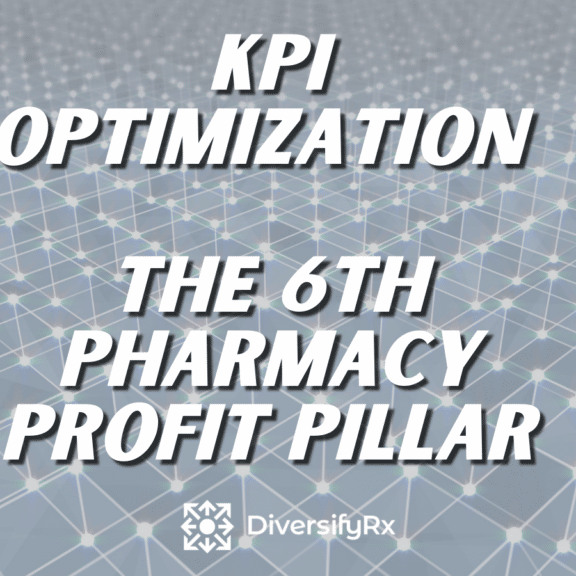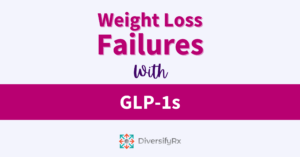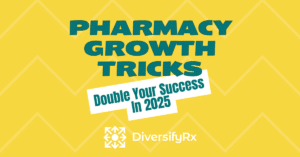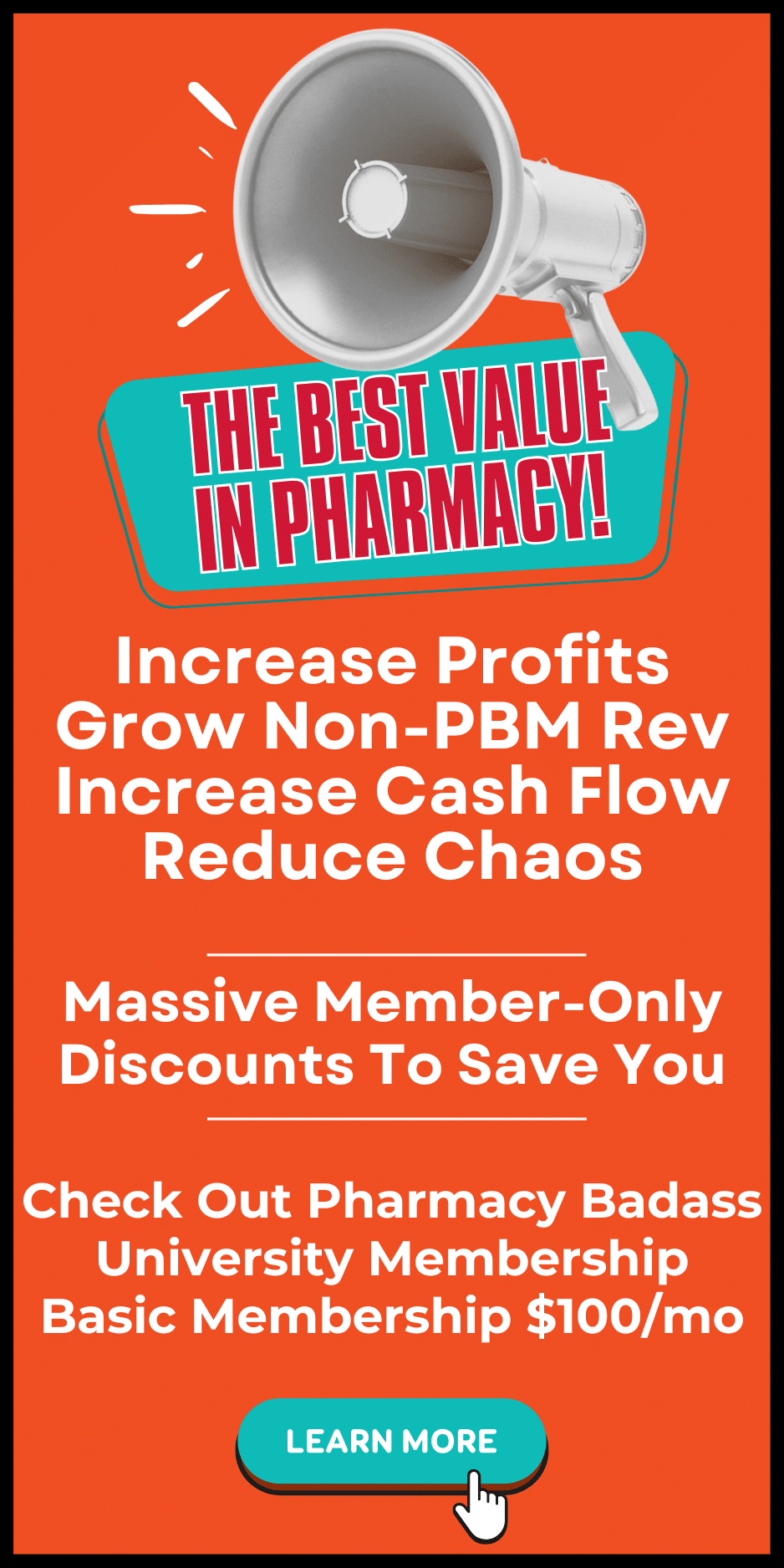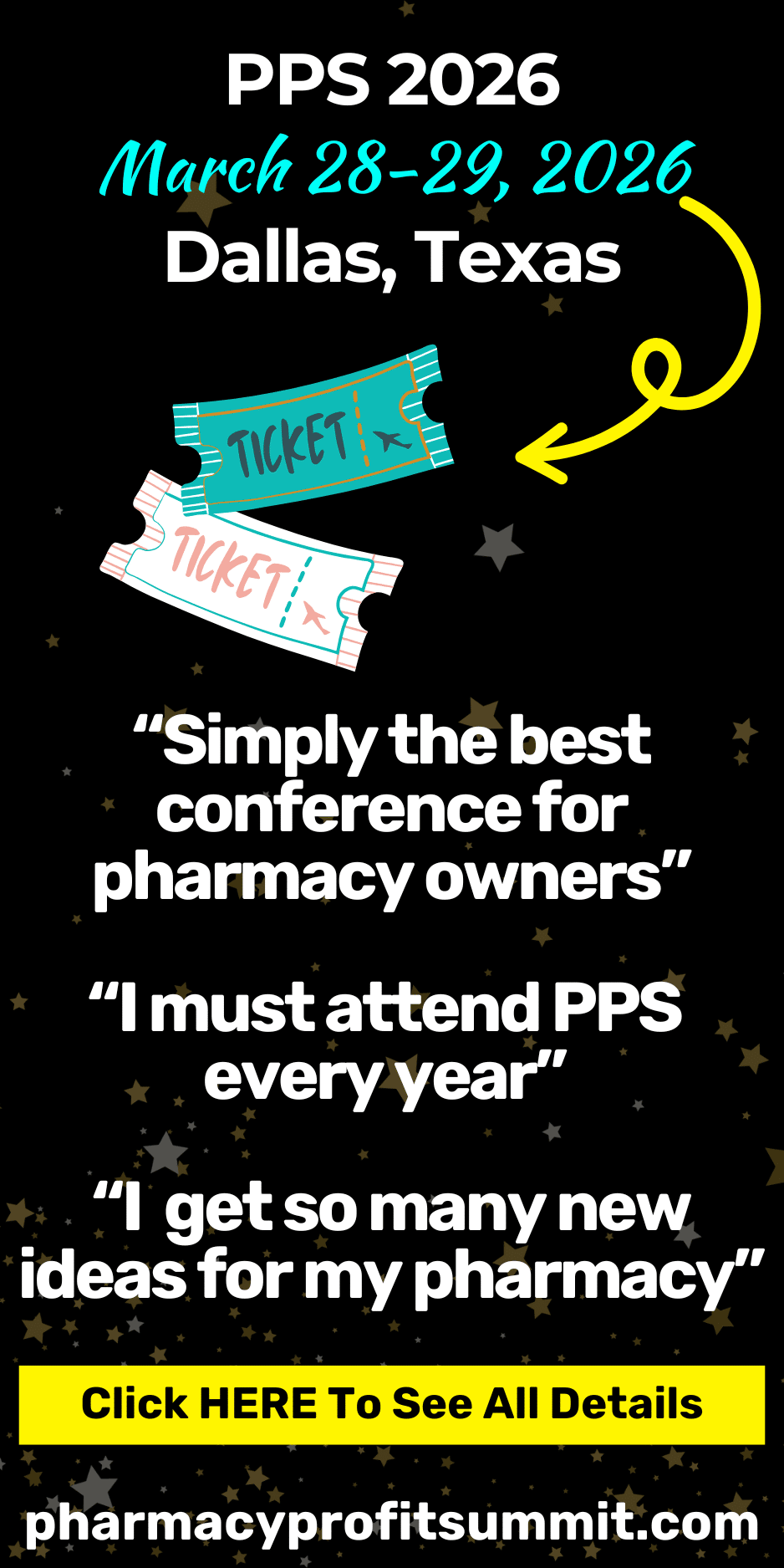KPI stands for Key Performance Indicator. A KPI is a data point or number you can track in your pharmacy. I am a data nerd, so I have written on several KPIs; feel free to browse through all KPI-related blogs HERE.
While there are 100s you could track in your pharmacy, what you want is a practical number of KPIs that will help you get to the core profitability of your pharmacy. This blog will dive into a basic overview of the five KPIs you should optimize to rev up your pharmacy profits and start your Pharmacy Badass journey.
Inventory Turns
You’ve probably heard me say, “A fat inventory equals a skinny wallet.” If you’re having cash flow problems, I’m betting your inventory is too high for your revenue level. Inventory is a significant drain on money and must be handled extremely efficiently.
If math and numbers aren’t your things, that’s okay! Get your accountant or bookkeeper to help you. For our Pharmacy Badass University members, you have full access to our inventory optimization course and forms so you can easily calculate and track this critical number.
What Should Be An Inventory Turns Goal?
Gone are the days of a 12-turn target. Gone too are the 16-turns number. Because of low profits and tight cash flow, pharmacy stock levels should at least be maintained at 20 turns – the best performing pharmacies are turning in the mid to high 20s and even 30s.
If you’re under 20 turns, it is time to rethink your inventory management. You need to time your buying better, reduce unnecessary bottles and increase your just-in-time inventory.
Do you have too many products on the shelves? It’s time for spring cleaning, no matter what month it is. Do an inventory cleanup to return eligible items to the wholesalers, sell unreturnable stock to other local pharmacies, or even use an exchange if your state allows it.
Do you have too many expired products? Then return to a reverse distributor to get a credit. I think the best on the market is Flash Returns.
Daily consistent inventory management is the way to win this race. A great way to slowly lower your inventory and maintain is to ensure your daily order amount is below your daily COGS. This will prevent your list from getting bloated again.
To Calculate: Inventory Turns = Annualized Cost of Goods Sold* ÷ Current Inventory Value
*You can also take your COGS for the past month, then multiply by 12
Benchmark: Above 20
Expense Ratio
The expense ratio assesses your pharmacy’s costs concerning your sales. This shows how efficiently your pharmacy is run. If you want higher profits, lower your operating costs!
Your expenses are everything you spend money on, from rent to payroll, electricity, marketing, and taxes. This does not include your COGS (cost of goods sold). You need to pay extra special attention to your expenses. You might need to invest more time shopping around or negotiating better deals. See if you can get vials for 10% cheaper if you buy three boxes.
FYI – an 8% inflation rate will erode HALF of a typical pharmacy’s profits. An ordinary expense ratio of 19% will creep up to 21.5% (8% higher), which cuts your net income from 3% to 1.5%. POOF – half your profits are gone. Check out our quick YouTube video that goes through these numbers.
Review your P&L (profit and loss statement) regularly. Ask your vendors to save unnecessary expenses. One of my favorite ways is unsexy. Save on your ink and toner with PSA.
To Calculate: Operating Expense Ratio = Total Operating Expenses ÷ Total Revenues.
Benchmark: Less than 19%
Payroll Ratio
Of course, you’ll need employees to keep your pharmacy running, but you don’t want payroll costs to get out of hand since it would put a lot of strain on the profitability of your pharmacy.
Everything that goes into paying employees, including (and maybe even) yourself, is considered payroll costs. Salaries, bonuses, taxes, benefits, and insurance for all revenue-generating personnel are included here.
The most frequently asked question is whether the owner’s compensation should be included in the calculation. If so, yes.
What if the owner is paid more or less than the market rate for their position? Then you will have to adjust the numbers to get an accurate calculation. If the owner is paid but doesn’t contribute to the dispensing, then that payroll wouldn’t count.
Clear as mud? Feel free to reach out to DiversifyRx; we are happy to help.
What To Do If Your Ratio Is Too High?
Your payroll ratio is a math problem. You fix it by lowering your payroll amount or increasing your revenues. There are many ways to decrease your payroll expenses. A few examples are:
- letting someone go
- hiring an intern rather than a pharmacist
- adjusting pay
- optimize employees’ schedules and reduce overall hours
You can cut payroll across the board. Let employees take a 2-hour lunch twice a week, come in a half hour late, or leave a half hour early. It doesn’t sound like much, but the savings add up quickly.
It is much more fun to increase revenues, and some of the quickest ways to do that are to sell some fantastic supplements.
Explain to your staff that you must balance payroll with income, and if they can Increase revenue, then hours will stay high. But if payments are going to be down for the long term, you’ll need to make adjustments to payroll.
Non-PBM Revenue Ratio
The explanation of non-PBM income is pretty straightforward. Income that isn’t from a PBM. However, to get more precise, we also break it down into a cash-based revenue sub-category and profit pillar. Cash-based revenue has its perks and strategies, so we like to break it out and talk specifically about those opportunities. To calculate this number – If it is a revenue dollar and doesn’t come from a PBM, you want to include it here.
Your pharmacy’s survival must increase the non-PBM income as much as possible. When 90% or more of your income is from a PBM, you are at the mercy of their rules, payment terms, audits, fees, clawbacks, and ever-changing contracts. Take back control of your pharmacy by increasing your non-PBM revenues.
What Is Your Percentage?
How much of your revenue comes from a PBM? If you aren’t sure, here is how to calculate it.
For the last month, run a report from your pharmacy management software for your dispensing history. It should provide you with the figures you charged to third parties. Take that figure and divide it by your total revenues for the same period. Now you have your proportion of income from a PBM, multiply by 100. Expect this figure to be 95 percent or higher if you are comparable to other pharmacies.
You can see this number as either a percentage of PBM revenue or non-PBM revenue. Both sides of the same coin will always add up to 100% of your income. You can track the one that is easiest for you to calculate.
Create a goal for the next quarter for where you want this number to be. First, find out where you are now. How much of your revenue is from a PBM?
For the first quarter, a good aim is to double your non-PBM revenue. So if you have 5% of revenue from non-PBM sources, set a goal for 10% in a quarter. This might appear like this.
- Your total annualized revenue is $4 million
- $200,000 a year, or 5%, comes from non-PBM sources, which is about $50,000 a quarter
- To get to 10%, you would need $100,000 in non-PBM revenues the next quarter
- Customize this to your specific situation; doubling may be too aggressive or insufficient.
For a deeper dive into Non-PBM Revenue, check out our blog that dives further into this!
Net Profit Dollars
As the queen of pharmacy KPIs, I enjoy benchmarking data. I like knowing what I should be doing to thrive so that I may make a strategy to get it even better. Net profit dollars are also known as your “bottom line.” This is the money you have made and get to take home, in a sense. This is the king of all numbers.
I suggest you look at your pharmacy’s net dollar and net profit percentage. What matters to you is the dollars. You can’t pay bills with percentages. However, when comparing yourself to a benchmark or other pharmacies, you will want to reach your net profit percentage.
Here is an example of why you want to compare percentages.
For example, if a $10 million dollar revenue pharmacy has $250,000 in net profit dollars, it appears to be better than another pharmacy with $150,000 in net profit dollars. Right?
The second pharmacy, on the other hand, has sales of $4 million. The second pharmacy is doing considerably better. So, make sure you use a net profit percentage when comparing yourself to other pharmacies. Looking at dollars is OK to use when looking at your improvement curve.
Every point of improvement you attempt to make in your pharmacy will eventually be seen in your net profit. This is why it is the king of KPIs. If you buy an automation machine, hire a new employee, or fire an old employee, no matter what, you will see an impact on your profit. Judging your decisions and their influence on your profit is always a good exercise.
Remember, your pharmacy is here to help patients and make a profit.
To learn about other strategies to help improve the profitability of your pharmacy, be sure to join Pharmacy Badass University and get a proven roadmap to increased profits with built-in KPI data trackers and on-demand classes.
If you are not ready to join the Pharmacy Badass University, check out DiversifyRx’s private Facebook Group or email us at in**@*********rx.com.




